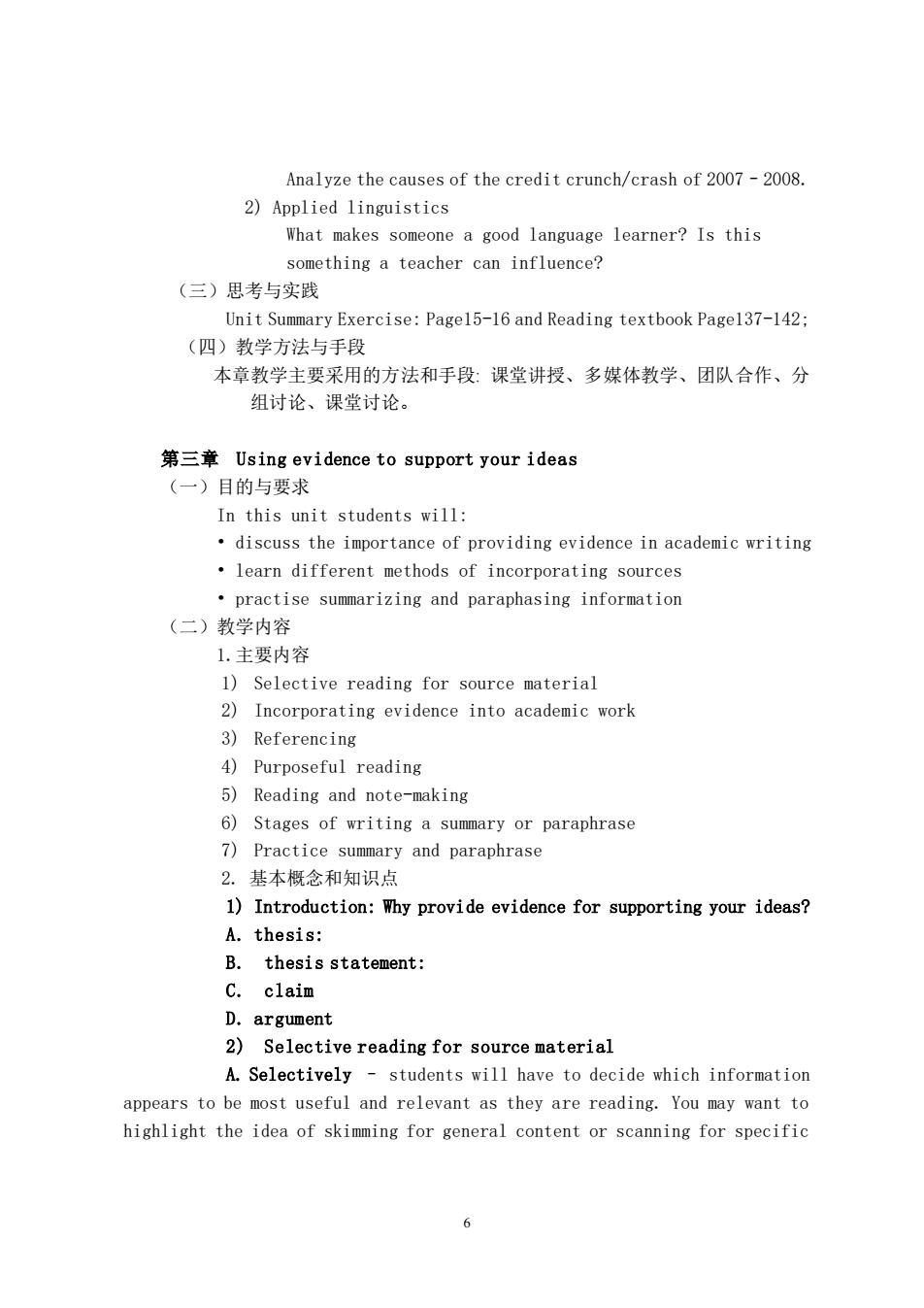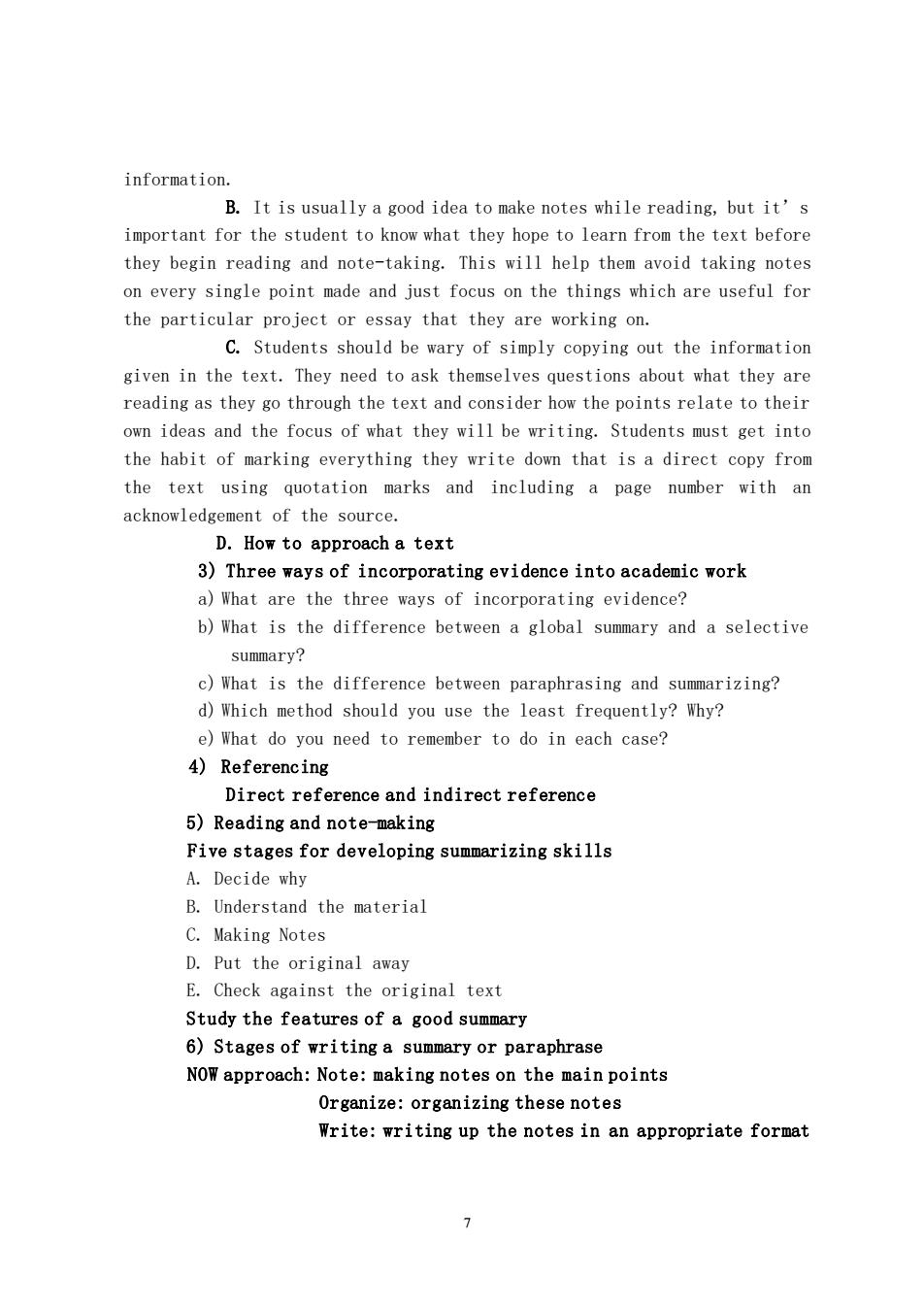
Analyze the causes of the credit crunch/crash of 2007-2008. 2)Applied linguistics What makes someone a good language learner?Is this something a teacher can influence? (三)思考与实践 Unit Summary Exercise:Page15-16 and Reading textbook Pagel37-142; (四)教学方法与手段 本章教学主要采用的方法和手段:课堂讲授、多媒体教学、团队合作、分 组讨论、课堂讨论。 第三章Using evidence to support your ideas (一)目的与要求 In this unit students will: discuss the importance of providing evidence in academic writing learn different methods of incorporating sources practise summarizing and paraphasing information (二)教学内容 1.主要内容 1)Selective reading for source material 2)Incorporating evidence into academic work 3)Referencing 4)Purposeful reading 5)Reading and note-making 6)Stages of writing a summary or paraphrase 7)Practice summary and paraphrase 2.基本概念和知识点 1)Introduction:Why provide evidence for supporting your ideas? A.thesis: B.thesis statement: C.claim D.argument 2)Selective reading for source material A.Selectively students will have to decide which information appears to be most useful and relevant as they are reading.You may want to highlight the idea of skimming for general content or scanning for specific 6
6 Analyze the causes of the credit crunch/crash of 2007–2008. 2) Applied linguistics What makes someone a good language learner? Is this something a teacher can influence? (三)思考与实践 Unit Summary Exercise: Page15-16 and Reading textbook Page137-142; (四)教学方法与手段 本章教学主要采用的方法和手段: 课堂讲授、多媒体教学、团队合作、分 组讨论、课堂讨论。 第三章 Using evidence to support your ideas (一)目的与要求 In this unit students will: • discuss the importance of providing evidence in academic writing • learn different methods of incorporating sources • practise summarizing and paraphasing information (二)教学内容 1.主要内容 1) Selective reading for source material 2) Incorporating evidence into academic work 3) Referencing 4) Purposeful reading 5) Reading and note-making 6) Stages of writing a summary or paraphrase 7) Practice summary and paraphrase 2. 基本概念和知识点 1) Introduction: Why provide evidence for supporting your ideas? A. thesis: B. thesis statement: C. claim D. argument 2) Selective reading for source material A. Selectively – students will have to decide which information appears to be most useful and relevant as they are reading. You may want to highlight the idea of skimming for general content or scanning for specific

information. B.It is usually a good idea to make notes while reading,but it's important for the student to know what they hope to learn from the text before they begin reading and note-taking.This will help them avoid taking notes on every single point made and iust focus on the things which are useful for the particular project or essay that they are working on. C.Students should be wary of simply copying out the information given in the text.They need to ask themselves questions about what they are reading as they go through the text and consider how the points relate to their own ideas and the focus of what they will be writing.Students must get into the habit of marking everything they write down that is a direct copy from the text using quotation marks and including a page number with an acknowledgement of the source D.How to approach a text 3)Three ways of incorporating evidence into academic work a)What are the three ways of incorporating evidence? b)What is the difference between a global summary and a selective summary? c)What is the difference between paraphrasing and summarizing? d)Which method should you use the least frequently?Why? e)What do you need to remember to do in each case? 4)Referencing Direct reference and indirect reference 5)Reading and note-making Five stages for developing summarizing skills A.Decide why B.Understand the material C.Making Notes D.Put the original away E.Check against the original text Study the features of a good summary 6)Stages of writing a summary or paraphrase NOW approach:Note:making notes on the main points Organize:organizing these notes Write:writing up the notes in an appropriate format
7 information. B. It is usually a good idea to make notes while reading, but it’s important for the student to know what they hope to learn from the text before they begin reading and note-taking. This will help them avoid taking notes on every single point made and just focus on the things which are useful for the particular project or essay that they are working on. C. Students should be wary of simply copying out the information given in the text. They need to ask themselves questions about what they are reading as they go through the text and consider how the points relate to their own ideas and the focus of what they will be writing. Students must get into the habit of marking everything they write down that is a direct copy from the text using quotation marks and including a page number with an acknowledgement of the source. D. How to approach a text 3) Three ways of incorporating evidence into academic work a) What are the three ways of incorporating evidence? b) What is the difference between a global summary and a selective summary? c) What is the difference between paraphrasing and summarizing? d) Which method should you use the least frequently? Why? e) What do you need to remember to do in each case? 4) Referencing Direct reference and indirect reference 5) Reading and note-making Five stages for developing summarizing skills A. Decide why B. Understand the material C. Making Notes D. Put the original away E. Check against the original text Study the features of a good summary 6) Stages of writing a summary or paraphrase NOW approach: Note: making notes on the main points Organize: organizing these notes Write: writing up the notes in an appropriate format